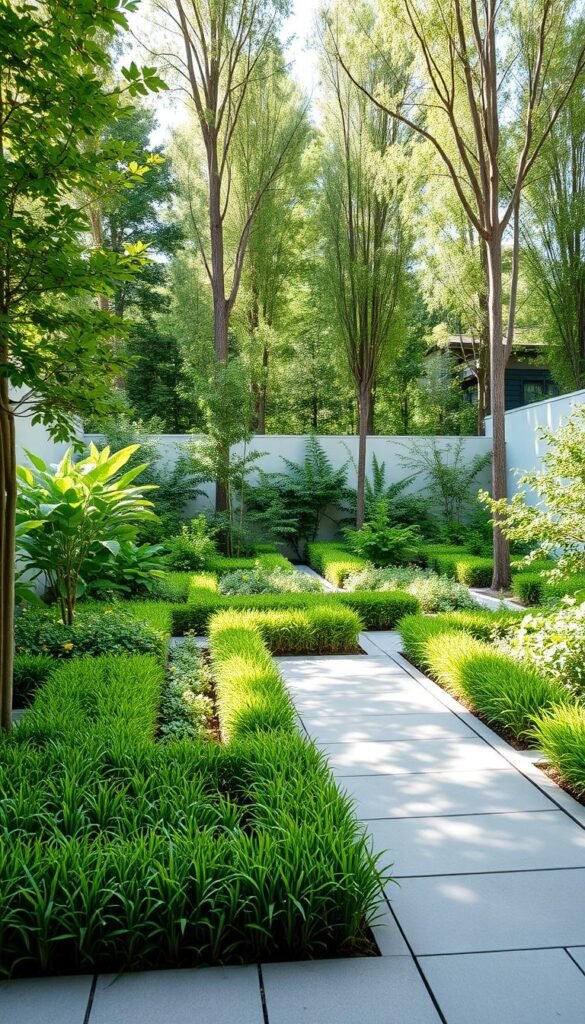Welcome to a world where creativity shapes nature. Modern garden design blends art with purpose, turning basic yards into eye-catching retreats. Whether you’re refining flower beds or reimagining pathways, today’s solutions balance beauty with smart functionality.
Think beyond traditional lawns. Current trends focus on structure and definition. Simple touches like crisp edging create visual flow while keeping mulch in place during storms. These details make spaces feel intentional—like they’ve been professionally curated.
Your property deserves more than generic layouts. Sustainable materials and bold shapes let you express personal style while boosting curb appeal. Did you know clean borders can reduce weed growth by 40%? Practical perks meet aesthetic gains effortlessly here.
Ready to explore innovations that work as hard as they impress? We’ll break down clever edging techniques, material swaps, and layout tweaks that turn ordinary areas into standout features. Let’s build a landscape that mirrors your vision—and maybe even surprises you.
Setting the Stage for a Stunning Outdoor Space
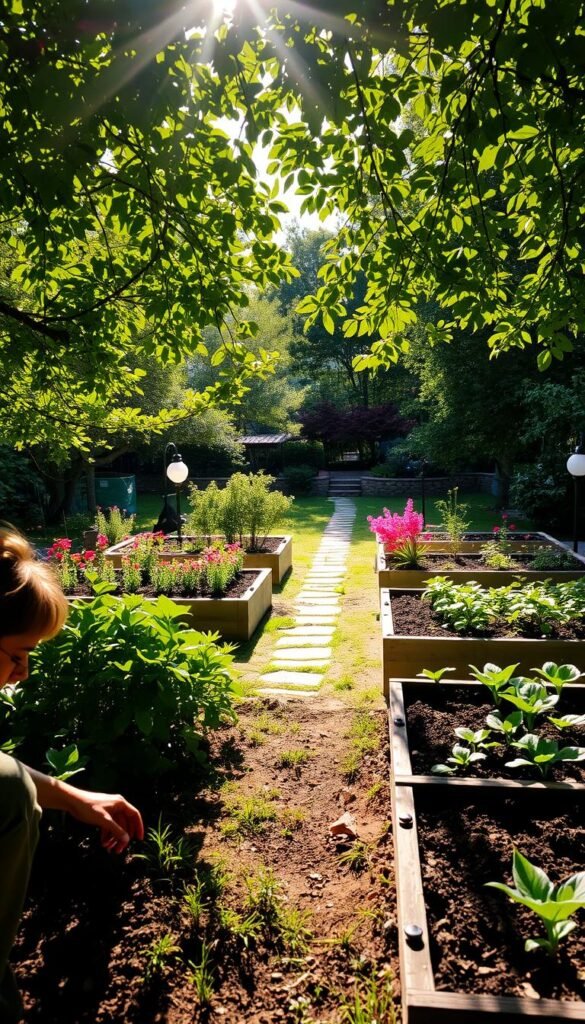
Your outdoor space is like a blank canvas—it just needs the right vision. Start by walking through your yard with fresh eyes. Notice where sunlight lingers in the morning or where puddles form after rain. These clues shape what’s possible.
Understanding Your Garden’s Potential
Soil quality and drainage patterns matter more than you think. Stick a shovel in the ground—if water pools in the hole, you’ll need drainage solutions. Track sun exposure across your area throughout the day. Shady spots might host ferns, while sunny zones could burst with wildflowers.
Don’t fight nature’s quirks. Wind patterns determine where to place tall plants or seating areas. Seasonal changes? They’ll show you which corners stay warm in winter or bake in summer.
Defining Style and Function
Do you crave clean lines or cozy chaos? Modern minimalism thrives with geometric shapes, while rustic charm embraces uneven stones and weathered wood. Your garden should reflect how you live—not just look pretty.
Balance beauty with reality. Low-maintenance gravel paths save time if you’re busy. Budget-friendly native plants thrive without constant care. Remember: A design that fits your lifestyle lasts longer than fleeting trends.
Consider Your Garden Edging Options
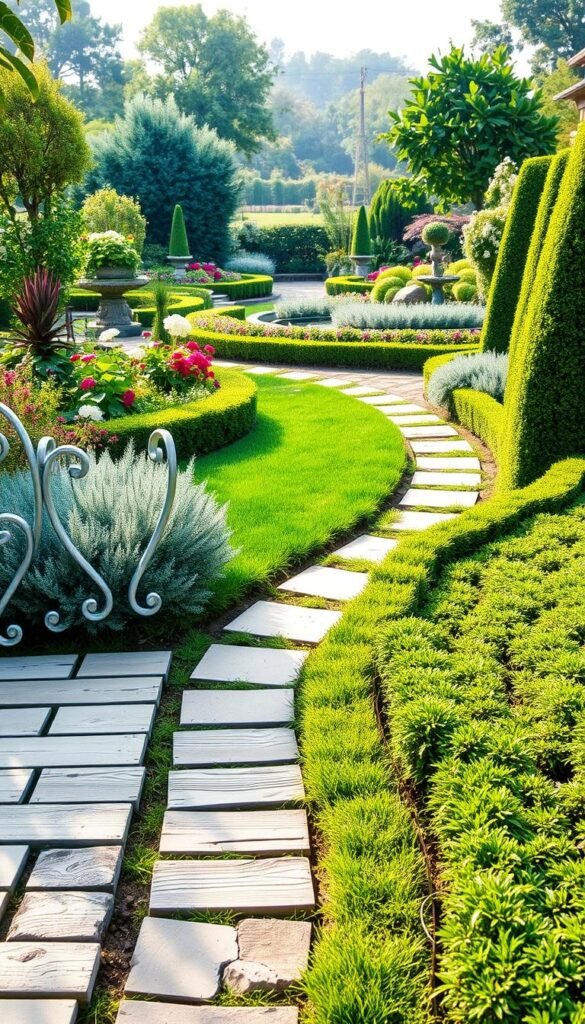
Edging defines more than just boundaries—it shapes your landscape’s personality. Your choice of materials acts like a frame for living art, blending practicality with visual rhythm. Let’s explore how different textures and forms can elevate ordinary beds into polished features.
Exploring Materials: Brick, Stone, Metal, and More
Brick offers timeless flexibility. Arrange classic red rectangles in zigzags for playful energy or stack scalloped terracotta pieces for Old World charm. Want subtle contrast? Try gray pavers against vibrant blooms. These options adapt to curves or sharp angles effortlessly.
Natural stone brings earthy textures. Smooth river rocks create soft borders, while jagged granite adds rugged drama. Mix limestone slabs with creeping thyme for a cottage vibe. Each type weathers uniquely, developing character over time.
For sleek modernity, consider metal strips. Aluminum stays rust-free in rainy climates, while corten steel develops a warm patina. These thin barriers block invasive roots and grass, keeping edges crisp with minimal upkeep. Pair them with gravel paths for industrial flair.
Your climate and lifestyle dictate the best fit. Humid areas? Avoid untreated wood that rots. Frequent foot traffic? Choose sturdy flagstone. With endless options, you’ll find solutions that look intentional and work harder than they seem.
Embrace Contemporary Materials for Edging
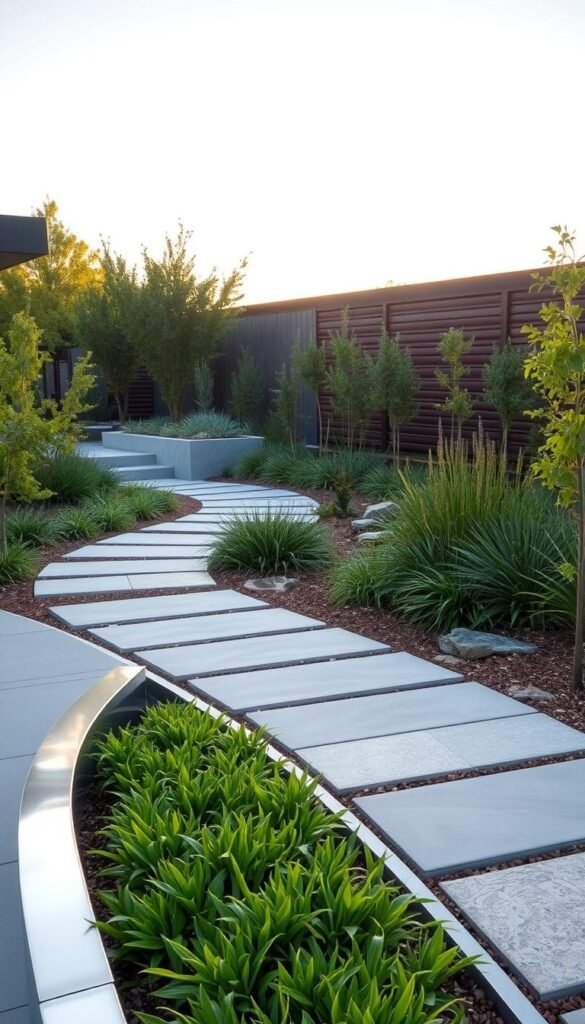
Transform your landscape’s edge from ordinary to extraordinary with materials built for modern living. Today’s best solutions combine industrial durability with artistic flexibility, letting you create boundaries that work as hard as they look good.
Steel That Ages Gracefully
Corten steel becomes more interesting over time. Its rust-like patina develops naturally, creating warm earthy tones that blend with desertscapes or urban spaces. This self-protecting finish means no paint chips or coatings to maintain – just install it and watch the character unfold.
Bendable panels let you shape curves around fire pits or circular beds. Pair these metallic ribbons with succulents or ornamental grasses for striking contrast. Perfect for Southwestern themes or industrial-chill patios.
Low-Upkeep Alternatives
Thin metal strips offer crisp lines without bulk. Aluminum versions resist corrosion near pools or coastal areas, staying sleek through harsh weather. For softer looks, try composite edging blending wood fibers with recycled plastic edging.
These hybrids mimic natural wood grain but won’t rot or splinter. Available in espresso browns to driftwood grays, they’re a great option for matching deck colors. Both choices install faster than traditional bricks – often with simple stakes and a rubber mallet.
Discover Cutting-Edge Garden Design Ideas to Elevate Your Landscape
Rethink how you shape outdoor areas by blending creativity with eco-smart solutions. Modern layouts now merge practicality with unexpected beauty—think drought-resistant succulents hugging geometric stone paths or wildflower clusters bursting through sleek metal grids.
Layering textures and heights adds drama to flat yards. Try feathery grasses behind low-growing thyme, topped with sculptural shrubs. This approach guides the eye while creating habitats for butterflies and bees. Pair vertical trellises with creeping vines to maximize small plots.
Hardscape elements anchor these living features beautifully. Flagstone walkways edged with creeping jenny soften edges, while gravel patios dotted with potted herbs bridge indoor-outdoor flow. For more tips on elevating your space with smart aesthetics, explore our guide.
| Design Approach | Key Features | Best For |
|---|---|---|
| Xeriscaping | Rock gardens, native plants | Dry climates |
| Pollinator Gardens | Colorful blooms, host plants | Wildlife support |
| Edible Landscaping | Fruit trees, herb spirals | Urban food production |
Eco-conscious choices drive today’s best layouts. Rain chains divert water to thirsty plants, while permeable pavers reduce runoff. Native species like coneflowers thrive with minimal care, offering seasonal color without constant fuss.
These concepts prove style and sustainability aren’t rivals. Your yard becomes a living ecosystem that delights the senses while respecting natural resources—no compromise needed.
Utilize Natural Elements for Rustic Charm
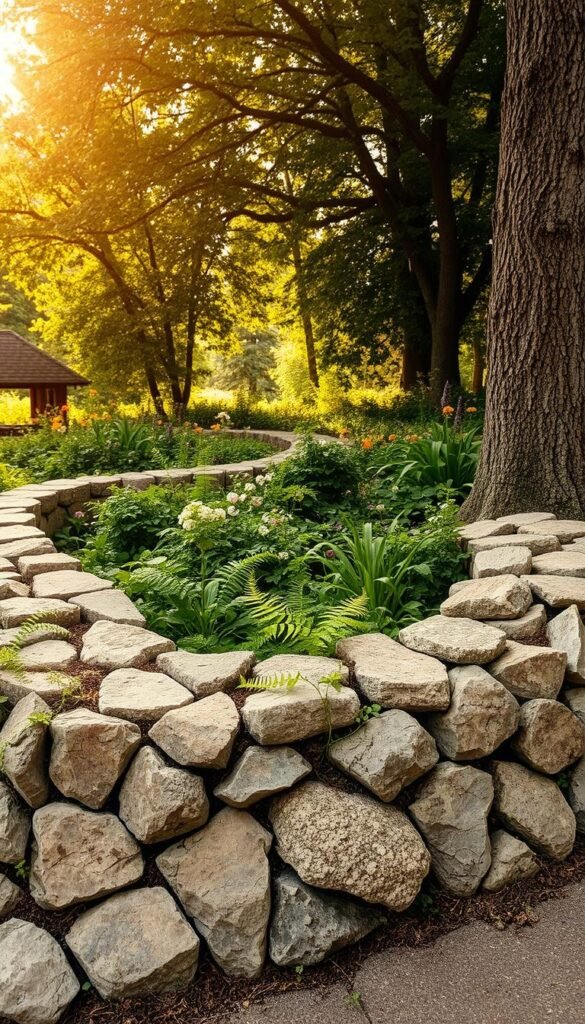
Nature offers ready-made solutions for creating edges that feel both timeless and inviting. By working with organic materials, you craft boundaries that blend into their surroundings while adding warmth.
Stone, Wood, and Earth: A Trio That Works
Fallen trees become free design assets. Cut trunks into 6-inch slices for circular bed borders or lay branches sideways along pathways. This approach gives charm while reducing waste—winning for your space and the planet.
Local stones ensure harmony with your region’s geology. Granite boulders anchor Southwest-style yards, while smooth limestone fits cottage settings. Mix sizes for dynamic edges: tuck pea gravel between larger rocks to prevent soil spillage.
| Stone Type | Best Use | Regional Fit |
|---|---|---|
| Granite | Sloped beds | Mountain states |
| Limestone | Flat borders | Midwest |
| Slate | Modern layouts | Northeast |
| River Rocks | Curved edges | Coastal areas |
Gravel adds crunch underfoot and defines casual paths. Choose earthy tones like buff or gray to complement your plants. For a cottagecore aesthetic, pair irregular stones with creeping thyme and weathered logs.
Remember: uneven arrangements often look most natural. Cluster three small rocks beside a lone larger one, then repeat the pattern. This rhythm guides the eye without feeling rigid.
Maximize Functionality with Practical Edging Solutions
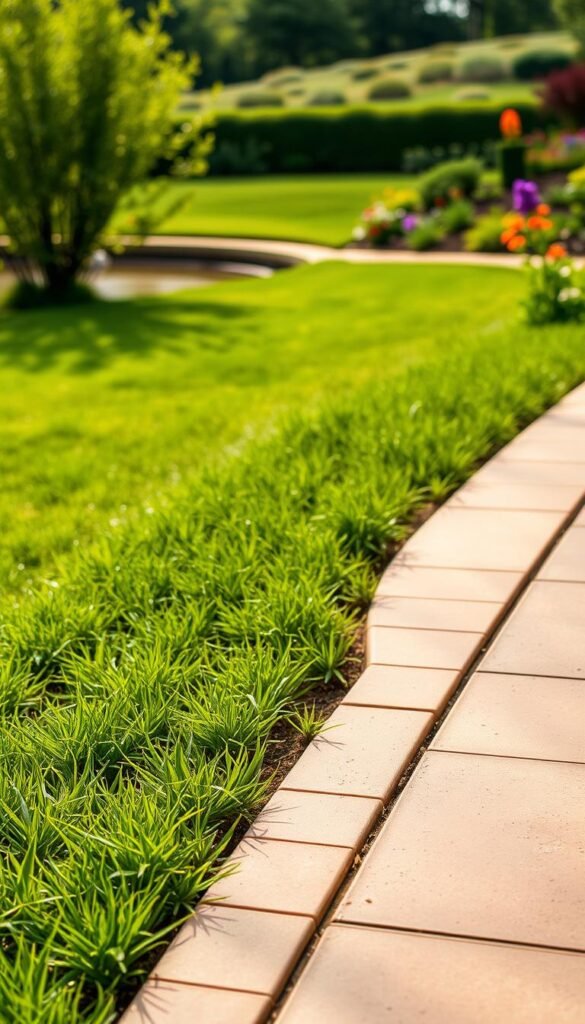
Busy schedules demand smart solutions that deliver results without draining weekends. Modern edging options now prioritize easy install features and long-term resilience, letting you focus on enjoying your space rather than maintaining it.
Quick Install Options and Low-Maintenance Ideas
Recycled plastic strips lead the pack for hassle-free setups. Their flexibility allows shaping around curves, while UV-resistant formulas prevent fading. “You’ll spend more time choosing plants than installing these borders,” notes a landscape designer. Here’s how it works:
- Dig a shallow trench (2-3 inches deep)
- Press edging into place, connecting segments
- Secure with included stakes every 18 inches
Pound-in systems skip digging entirely. Serrated edges grip soil as you tap them with a mallet—ideal for rocky ground or tree roots. Pair these with mulch to suppress weeds and retain moisture.
| Material | Install Time | Durability |
|---|---|---|
| Recycled Plastic | 45 mins per 25 ft | 15+ years |
| Aluminum Strips | 30 mins per 25 ft | 20+ years |
| Rubber Edging | 60 mins per 25 ft | 10+ years |
For budget-friendly garden projects, combine these edging types with gravel paths or wood chips. They withstand string trimmers and winter frost heave, staying crisp through seasons. Choose textured finishes to hide minor scratches from lawn tools.
Your garden edging should work harder than you do. With these options, you’ll create defined spaces that look polished for many years—no constant tweaking required.
Personalize Your Landscape with Unique Materials
Your outdoor space becomes truly yours when you mix classic elements with creative flair. Brick and timber offer endless ways to craft borders that feel both nostalgic and fresh. These materials adapt to your vision—whether you want structured symmetry or free-flowing curves.
Brick Patterns That Tell Stories
Traditional brick edging shines when you play with layouts. Try herringbone patterns for formal cottage gardens or stack bricks vertically beside wildflower beds. Aged terracotta pieces with scalloped edges bring Old World charm to pathways. Gray weathered varieties pair perfectly with modern succulents.
Wood adds warmth that evolves over time. Thick cedar planks create crisp lines for contemporary yards, while reclaimed railroad ties suit rugged landscapes. For a softer look, use weathered oak slices as low-profile borders around herb spirals.
Choose rot-resistant species based on your climate:
- Redwood thrives in humid regions
- Cedar withstands dry heat
- Black locust resists insect damage
Mix materials for unexpected harmony. Line a brick-edged patio with horizontal timber slats. Alternate three bricks with a vertical wood post every few feet. These combos create rhythm while letting your personality shine through every detail.
Enhance Your Garden Bed for a Polished Look
Crisp edges transform messy beds into intentional designs. Start by marking your garden bed shape with spray paint or a hose. Cut a 3-inch-deep trench using a half-moon edger—this creates a clear line that stops grass from creeping in.
Proper edging acts like a fence for your plants. It keeps mulch contained during heavy rains and blocks invasive roots. For extra protection, tuck landscape fabric under the border before adding soil.
Techniques to Define Boundaries and Suppress Weeds
Mulch does double duty—it looks neat and smothers unwanted growth. Spread a 2-inch layer after edging to lock in moisture. Cocoa bean shells or cedar chips add pleasant scents while deterring pests.
Coco fiber rolls offer natural weed control. These biodegradable edges blend into organic setups seamlessly. Simply stake them along curved beds—they’ll last 2-3 seasons before composting naturally.
| Material | Best Use | Maintenance Level |
|---|---|---|
| Metal Strips | Straight lines | Low |
| Coco Fiber | Curved beds | Moderate |
| Recycled Plastic | Sloped areas | Low |
| Brick | Formal layouts | Medium |
Keep edges sharp with seasonal touch-ups. Run a flat spade along existing trenches every spring to redefine shapes. For lasting results, explore landscape edging ideas that match your soil type and plant choices.
Technology and Tools for Easy Edging Installation
Sharp edges define your landscape’s character, and the right tools make it simple. Modern innovations turn what used to be backbreaking work into manageable projects. Whether you’re tackling curved beds or straight lines, today’s equipment delivers precision without the strain.
Smart Gear for Clean Lines
Start with an edging shovel or half-moon spade. These tools slice through grass roots, creating crisp trenches that keep mulch contained. For larger areas, electric or gas-powered edgers zip through soil, reducing installation time by half.
Always make sure to mark your design first. Spray lawn paint lets you visualize curves or angles before cutting. This step prevents mistakes and ensures your edges align with existing pathways or plantings.
| Tool Type | Best Use Case | Maintenance Level |
|---|---|---|
| Manual Edger | Small beds, tight curves | Low (wipe blades) |
| Power Edger | Long straight edges | Medium (sharpen blades) |
| Lawn Paint | Complex designs | None (disposable) |
Safety matters. Wear gloves to avoid blisters and goggles when using power tools. Store metal blades dry to prevent rust, and clean plastic edging with a hose after installation.
Choose tools based on your project’s scale. A basic gardening toolkit covers most needs, while rentals suit one-time large jobs. Remember: sharp tools work better and safer than dull ones.
Striking Stone and Brick Edges for Bold Expression
Stone and brick edges turn functional borders into artistic statements. Imagine lavender spilling over a weathered limestone wall or plants cascading down stacked slate tiers. These materials add weight and permanence to your landscape while framing flower beds with rustic elegance.
How to Create Visual Impact with Patterned Edging
Play with geometric layouts for modern flair. A stone patio gains personality when smaller rocks radiate outward like sunbeams—a technique used in Amanda Reynal’s Catskills cottage. For traditional charm, lay bricks in herringbone patterns beside rose bushes.
Mix textures for depth. Pair chunky fieldstones with smooth river pebbles along winding paths. “Contrast makes edges pop,” says landscape architect Mia Thornton. Try irregular flagstone pieces interrupted by vertical brick columns every four feet.
Raised edges offer drama and function. Stack flat sandstone slabs to create mini retaining walls where creeping phlox can tumble freely. This approach works beautifully on slopes while preventing soil erosion during heavy rains.
Brick adapts to both formal and casual settings. Use reclaimed red varieties for cottage vibes or sleek gray pavers in minimalist spaces. Combine them with drought-tolerant sedums or feathery grasses that sway above the structured lines.
Versatile Options for Garden Bed Edging on a Budget
Smart edging doesn’t require deep pockets—just creative thinking. Start by looking at everyday items with fresh eyes. That empty wine bottle collection? It’s about to become your garden bed’s star feature.
Almost Free and Inexpensive Alternatives
Turn glass bottles into eye-catching borders. Dig a shallow trench and place them neck-down for instant color. Blues and greens catch sunlight beautifully, while amber tones add warmth. This eco-friendly twist keeps waste out of landfills and gives your space whimsy.
Plastic edging remains a practical pick for tight budgets. Rolls cost less than dinner for two and last decades. Bury the top edge slightly to hide the material while keeping grass roots in check. Pair it with mulch for a finished look that says you tried.
Prefer invisible boundaries? Grab an edging shovel. Cut a clean line between lawn and beds—it takes minutes but makes everything look intentional. Touch up these edges each spring to maintain sharp definition without spending a dime.
These options prove style and savings coexist. Whether you upcycle bottles or opt for no-cost tool work, your landscape gains polish through smart choices. Now go transform those edges—your wallet will thank you.

